ECO mode FORD MUSTANG 2022 Warranty Guide
[x] Cancel search | Manufacturer: FORD, Model Year: 2022, Model line: MUSTANG, Model: FORD MUSTANG 2022Pages: 81, PDF Size: 1.96 MB
Page 6 of 81
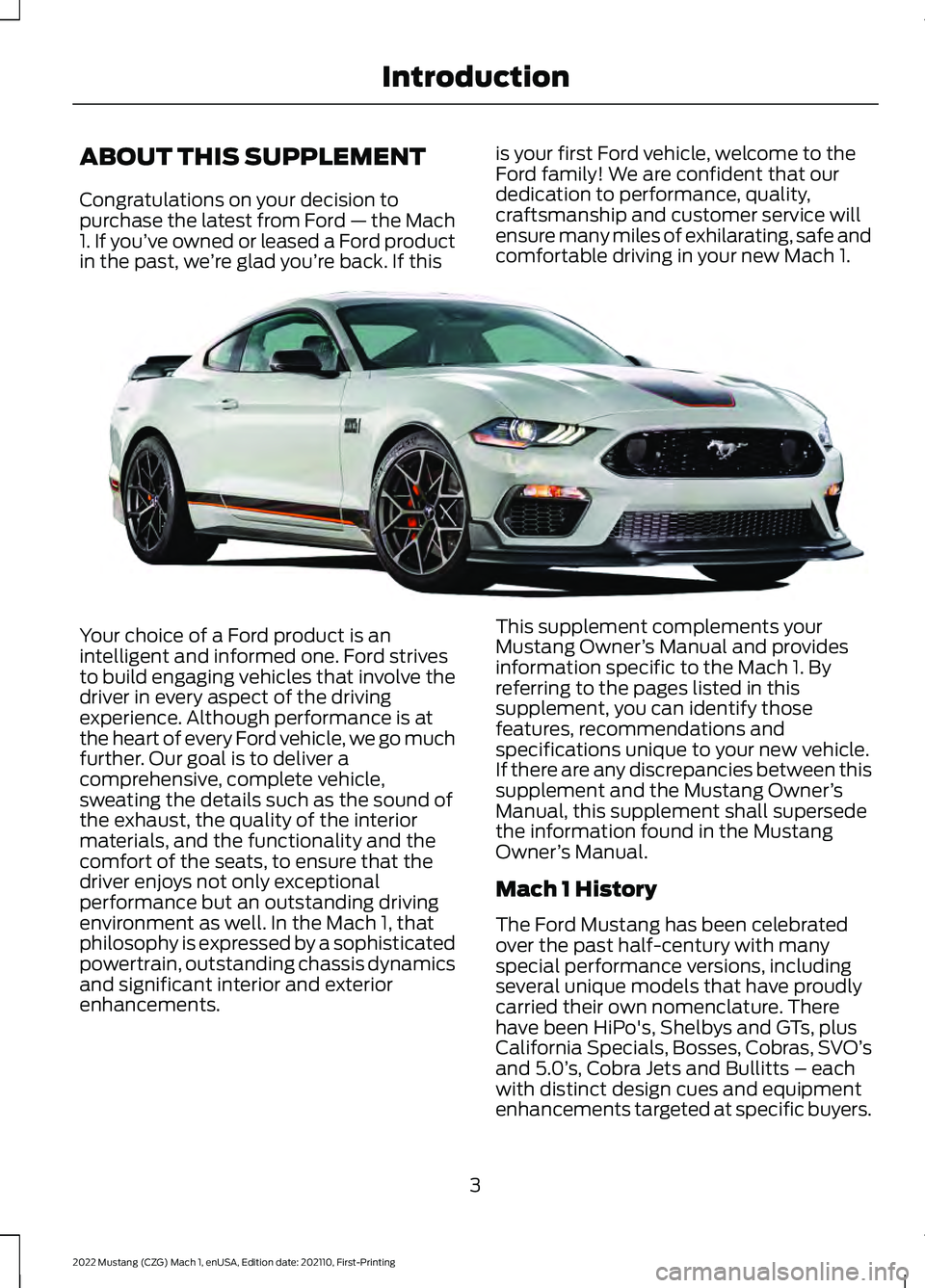
ABOUT THIS SUPPLEMENT
Congratulations on your decision to
purchase the latest from Ford — the Mach
1. If you’
ve owned or leased a Ford product
in the past, we ’re glad you’re back. If this is your first Ford vehicle, welcome to the
Ford family! We are confident that our
dedication to performance, quality,
craftsmanship and customer service will
ensure many miles of exhilarating, safe and
comfortable driving in your new Mach 1.Your choice of a Ford product is an
intelligent and informed one. Ford strives
to build engaging vehicles that involve the
driver in every aspect of the driving
experience. Although performance is at
the heart of every Ford vehicle, we go much
further. Our goal is to deliver a
comprehensive, complete vehicle,
sweating the details such as the sound of
the exhaust, the quality of the interior
materials, and the functionality and the
comfort of the seats, to ensure that the
driver enjoys not only exceptional
performance but an outstanding driving
environment as well. In the Mach 1, that
philosophy is expressed by a sophisticated
powertrain, outstanding chassis dynamics
and significant interior and exterior
enhancements.
This supplement complements your
Mustang Owner
’s Manual and provides
information specific to the Mach 1. By
referring to the pages listed in this
supplement, you can identify those
features, recommendations and
specifications unique to your new vehicle.
If there are any discrepancies between this
supplement and the Mustang Owner ’s
Manual, this supplement shall supersede
the information found in the Mustang
Owner ’s Manual.
Mach 1 History
The Ford Mustang has been celebrated
over the past half-century with many
special performance versions, including
several unique models that have proudly
carried their own nomenclature. There
have been HiPo's, Shelbys and GTs, plus
California Specials, Bosses, Cobras, SVO’ s
and 5.0’ s, Cobra Jets and Bullitts – each
with distinct design cues and equipment
enhancements targeted at specific buyers.
3
2022 Mustang (CZG) Mach 1, enUSA, Edition date: 202110, First-Printing IntroductionE339647
Page 8 of 81
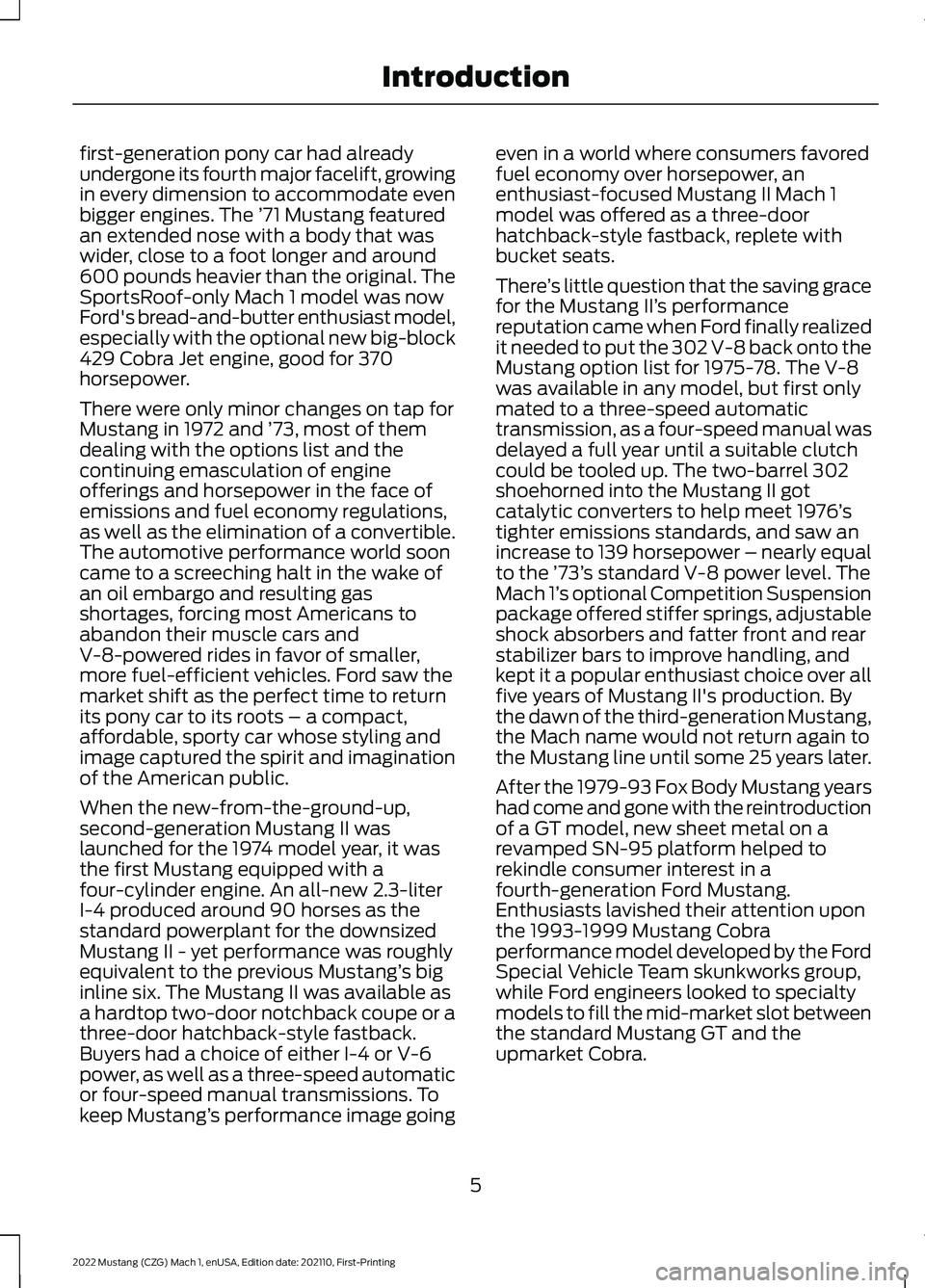
first-generation pony car had already
undergone its fourth major facelift, growing
in every dimension to accommodate even
bigger engines. The ’
71 Mustang featured
an extended nose with a body that was
wider, close to a foot longer and around
600 pounds heavier than the original. The
SportsRoof-only Mach 1 model was now
Ford's bread-and-butter enthusiast model,
especially with the optional new big-block
429 Cobra Jet engine, good for 370
horsepower.
There were only minor changes on tap for
Mustang in 1972 and ’ 73, most of them
dealing with the options list and the
continuing emasculation of engine
offerings and horsepower in the face of
emissions and fuel economy regulations,
as well as the elimination of a convertible.
The automotive performance world soon
came to a screeching halt in the wake of
an oil embargo and resulting gas
shortages, forcing most Americans to
abandon their muscle cars and
V-8-powered rides in favor of smaller,
more fuel-efficient vehicles. Ford saw the
market shift as the perfect time to return
its pony car to its roots – a compact,
affordable, sporty car whose styling and
image captured the spirit and imagination
of the American public.
When the new-from-the-ground-up,
second-generation Mustang II was
launched for the 1974 model year, it was
the first Mustang equipped with a
four-cylinder engine. An all-new 2.3-liter
I-4 produced around 90 horses as the
standard powerplant for the downsized
Mustang II - yet performance was roughly
equivalent to the previous Mustang’ s big
inline six. The Mustang II was available as
a hardtop two-door notchback coupe or a
three-door hatchback-style fastback.
Buyers had a choice of either I-4 or V-6
power, as well as a three-speed automatic
or four-speed manual transmissions. To
keep Mustang’ s performance image going even in a world where consumers favored
fuel economy over horsepower, an
enthusiast-focused Mustang II Mach 1
model was offered as a three-door
hatchback-style fastback, replete with
bucket seats.
There
’s little question that the saving grace
for the Mustang II’ s performance
reputation came when Ford finally realized
it needed to put the 302 V-8 back onto the
Mustang option list for 1975-78. The V-8
was available in any model, but first only
mated to a three-speed automatic
transmission, as a four-speed manual was
delayed a full year until a suitable clutch
could be tooled up. The two-barrel 302
shoehorned into the Mustang II got
catalytic converters to help meet 1976 ’s
tighter emissions standards, and saw an
increase to 139 horsepower – nearly equal
to the ’ 73’s standard V-8 power level. The
Mach 1’ s optional Competition Suspension
package offered stiffer springs, adjustable
shock absorbers and fatter front and rear
stabilizer bars to improve handling, and
kept it a popular enthusiast choice over all
five years of Mustang II's production. By
the dawn of the third-generation Mustang,
the Mach name would not return again to
the Mustang line until some 25 years later.
After the 1979-93 Fox Body Mustang years
had come and gone with the reintroduction
of a GT model, new sheet metal on a
revamped SN-95 platform helped to
rekindle consumer interest in a
fourth-generation Ford Mustang.
Enthusiasts lavished their attention upon
the 1993-1999 Mustang Cobra
performance model developed by the Ford
Special Vehicle Team skunkworks group,
while Ford engineers looked to specialty
models to fill the mid-market slot between
the standard Mustang GT and the
upmarket Cobra.
5
2022 Mustang (CZG) Mach 1, enUSA, Edition date: 202110, First-Printing Introduction
Page 18 of 81
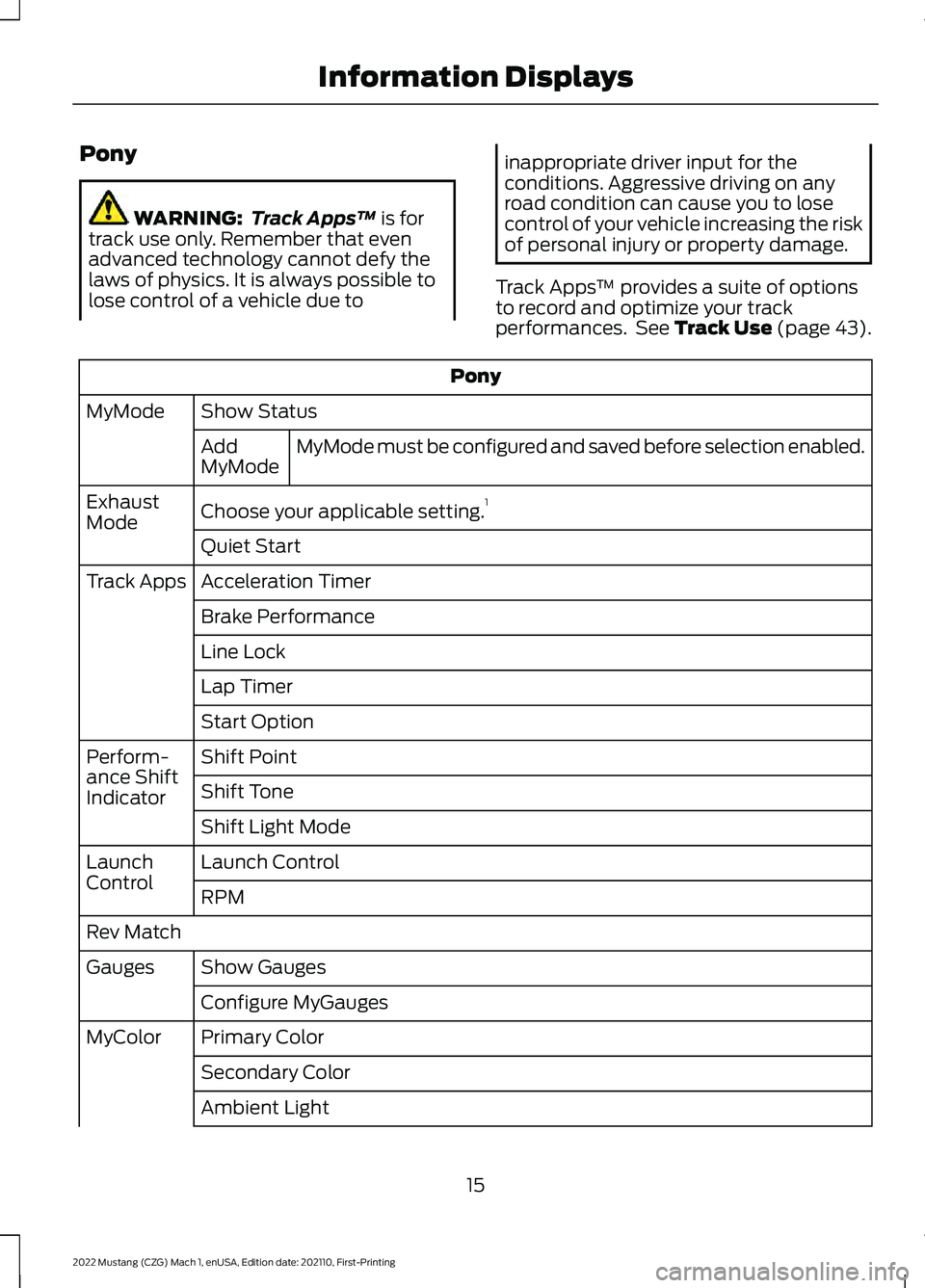
Pony
WARNING:
Track Apps™ is for
track use only. Remember that even
advanced technology cannot defy the
laws of physics. It is always possible to
lose control of a vehicle due to inappropriate driver input for the
conditions. Aggressive driving on any
road condition can cause you to lose
control of your vehicle increasing the risk
of personal injury or property damage.
Track Apps ™ provides a suite of options
to record and optimize your track
performances. See Track Use (page 43). Pony
Show Status
MyMode
MyMode must be configured and saved before selection enabled.
Add
MyMode
Choose your applicable setting. 1
Exhaust
Mode
Quiet Start
Acceleration Timer
Track Apps
Brake Performance
Line Lock
Lap Timer
Start Option
Shift Point
Perform-
ance Shift
Indicator Shift Tone
Shift Light Mode
Launch Control
Launch
Control
RPM
Rev Match Show Gauges
Gauges
Configure MyGauges
Primary Color
MyColor
Secondary Color
Ambient Light
15
2022 Mustang (CZG) Mach 1, enUSA, Edition date: 202110, First-Printing Information Displays
Page 24 of 81
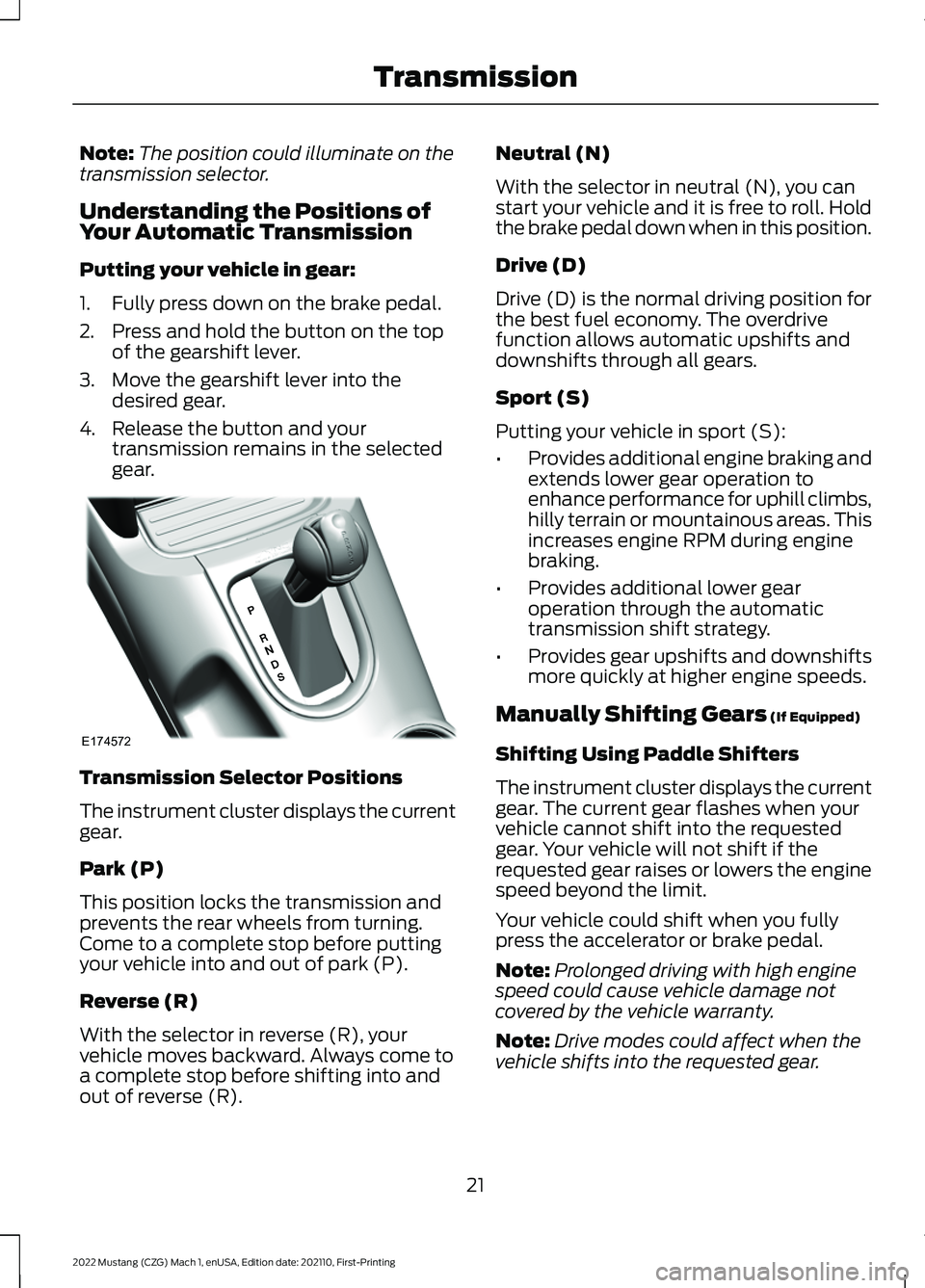
Note:
The position could illuminate on the
transmission selector.
Understanding the Positions of
Your Automatic Transmission
Putting your vehicle in gear:
1. Fully press down on the brake pedal.
2. Press and hold the button on the top of the gearshift lever.
3. Move the gearshift lever into the desired gear.
4. Release the button and your transmission remains in the selected
gear. Transmission Selector Positions
The instrument cluster displays the current
gear.
Park (P)
This position locks the transmission and
prevents the rear wheels from turning.
Come to a complete stop before putting
your vehicle into and out of park (P).
Reverse (R)
With the selector in reverse (R), your
vehicle moves backward. Always come to
a complete stop before shifting into and
out of reverse (R). Neutral (N)
With the selector in neutral (N), you can
start your vehicle and it is free to roll. Hold
the brake pedal down when in this position.
Drive (D)
Drive (D) is the normal driving position for
the best fuel economy. The overdrive
function allows automatic upshifts and
downshifts through all gears.
Sport (S)
Putting your vehicle in sport (S):
•
Provides additional engine braking and
extends lower gear operation to
enhance performance for uphill climbs,
hilly terrain or mountainous areas. This
increases engine RPM during engine
braking.
• Provides additional lower gear
operation through the automatic
transmission shift strategy.
• Provides gear upshifts and downshifts
more quickly at higher engine speeds.
Manually Shifting Gears (If Equipped)
Shifting Using Paddle Shifters
The instrument cluster displays the current
gear. The current gear flashes when your
vehicle cannot shift into the requested
gear. Your vehicle will not shift if the
requested gear raises or lowers the engine
speed beyond the limit.
Your vehicle could shift when you fully
press the accelerator or brake pedal.
Note: Prolonged driving with high engine
speed could cause vehicle damage not
covered by the vehicle warranty.
Note: Drive modes could affect when the
vehicle shifts into the requested gear.
21
2022 Mustang (CZG) Mach 1, enUSA, Edition date: 202110, First-Printing TransmissionE174572
Page 29 of 81
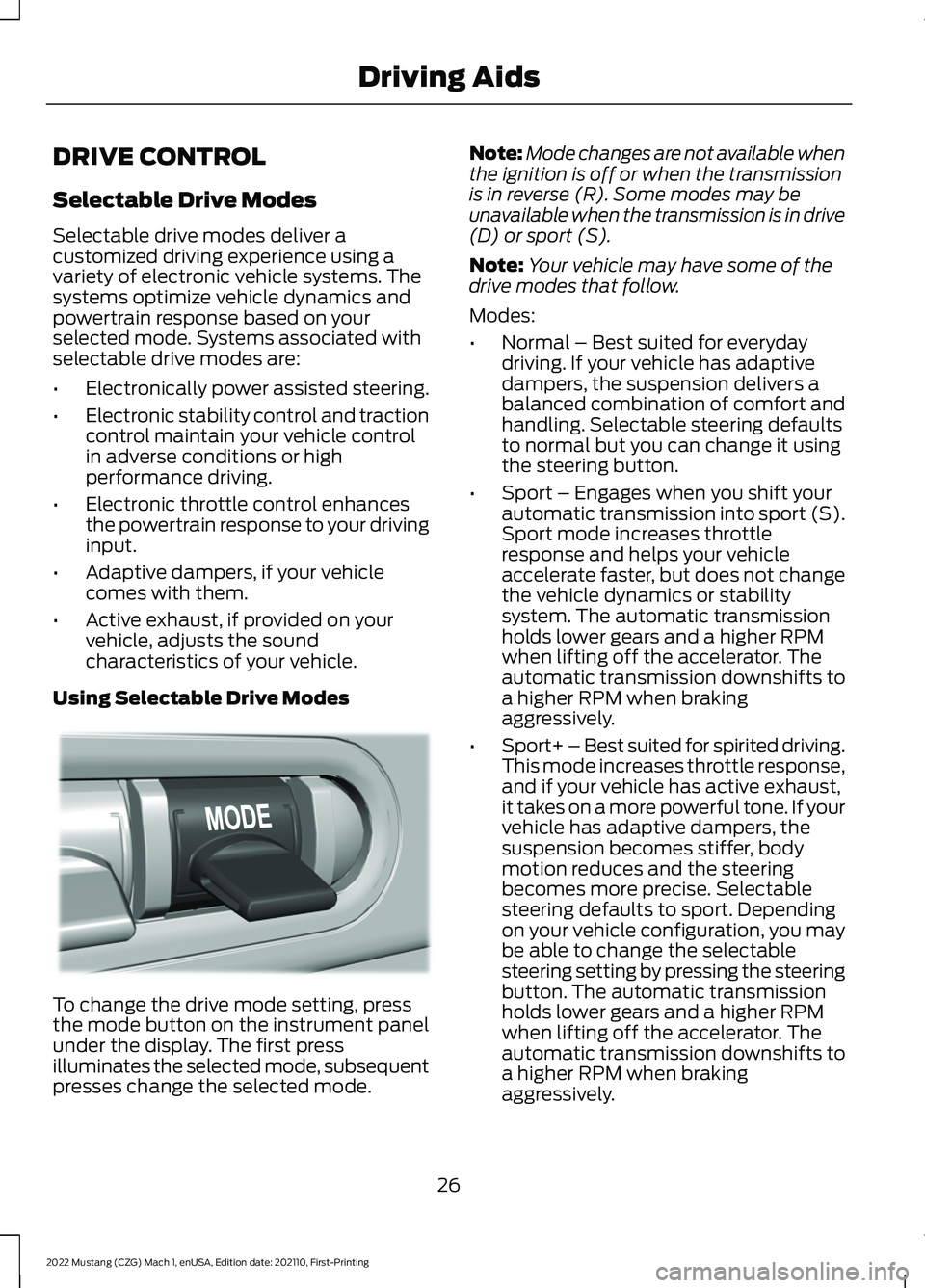
DRIVE CONTROL
Selectable Drive Modes
Selectable drive modes deliver a
customized driving experience using a
variety of electronic vehicle systems. The
systems optimize vehicle dynamics and
powertrain response based on your
selected mode. Systems associated with
selectable drive modes are:
•
Electronically power assisted steering.
• Electronic stability control and traction
control maintain your vehicle control
in adverse conditions or high
performance driving.
• Electronic throttle control enhances
the powertrain response to your driving
input.
• Adaptive dampers, if your vehicle
comes with them.
• Active exhaust, if provided on your
vehicle, adjusts the sound
characteristics of your vehicle.
Using Selectable Drive Modes To change the drive mode setting, press
the mode button on the instrument panel
under the display. The first press
illuminates the selected mode, subsequent
presses change the selected mode. Note:
Mode changes are not available when
the ignition is off or when the transmission
is in reverse (R). Some modes may be
unavailable when the transmission is in drive
(D) or sport (S).
Note: Your vehicle may have some of the
drive modes that follow.
Modes:
• Normal – Best suited for everyday
driving. If your vehicle has adaptive
dampers, the suspension delivers a
balanced combination of comfort and
handling. Selectable steering defaults
to normal but you can change it using
the steering button.
• Sport – Engages when you shift your
automatic transmission into sport (S).
Sport mode increases throttle
response and helps your vehicle
accelerate faster, but does not change
the vehicle dynamics or stability
system. The automatic transmission
holds lower gears and a higher RPM
when lifting off the accelerator. The
automatic transmission downshifts to
a higher RPM when braking
aggressively.
• Sport+ – Best suited for spirited driving.
This mode increases throttle response,
and if your vehicle has active exhaust,
it takes on a more powerful tone. If your
vehicle has adaptive dampers, the
suspension becomes stiffer, body
motion reduces and the steering
becomes more precise. Selectable
steering defaults to sport. Depending
on your vehicle configuration, you may
be able to change the selectable
steering setting by pressing the steering
button. The automatic transmission
holds lower gears and a higher RPM
when lifting off the accelerator. The
automatic transmission downshifts to
a higher RPM when braking
aggressively.
26
2022 Mustang (CZG) Mach 1, enUSA, Edition date: 202110, First-Printing Driving AidsE294773
Page 33 of 81
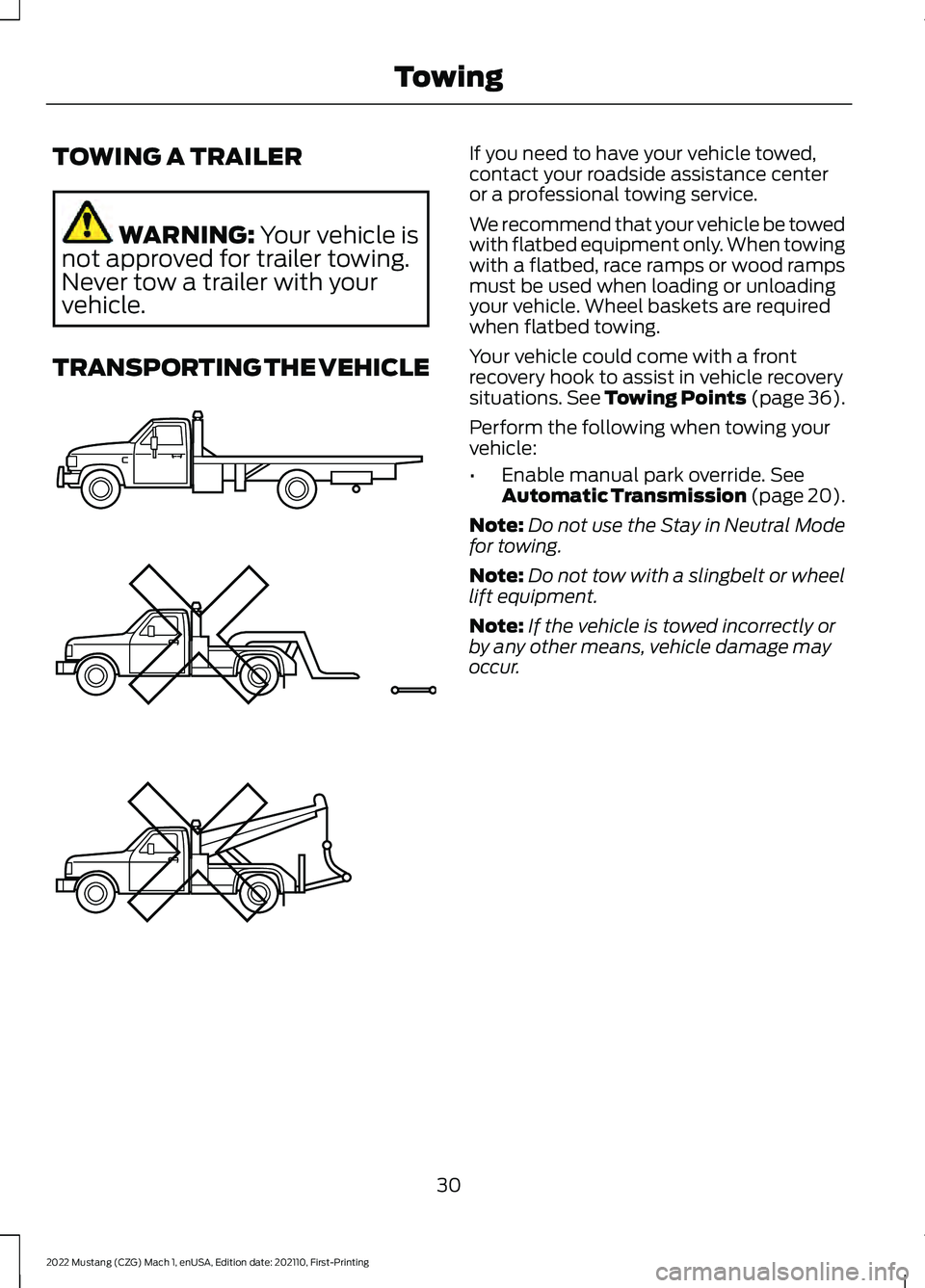
TOWING A TRAILER
WARNING: Your vehicle is
not approved for trailer towing.
Never tow a trailer with your
vehicle.
TRANSPORTING THE VEHICLE If you need to have your vehicle towed,
contact your roadside assistance center
or a professional towing service.
We recommend that your vehicle be towed
with flatbed equipment only. When towing
with a flatbed, race ramps or wood ramps
must be used when loading or unloading
your vehicle. Wheel baskets are required
when flatbed towing.
Your vehicle could come with a front
recovery hook to assist in vehicle recovery
situations.
See Towing Points (page 36).
Perform the following when towing your
vehicle:
• Enable manual park override.
See
Automatic Transmission (page 20).
Note: Do not use the Stay in Neutral Mode
for towing.
Note: Do not tow with a slingbelt or wheel
lift equipment.
Note: If the vehicle is towed incorrectly or
by any other means, vehicle damage may
occur.
30
2022 Mustang (CZG) Mach 1, enUSA, Edition date: 202110, First-Printing TowingE203788
Page 46 of 81
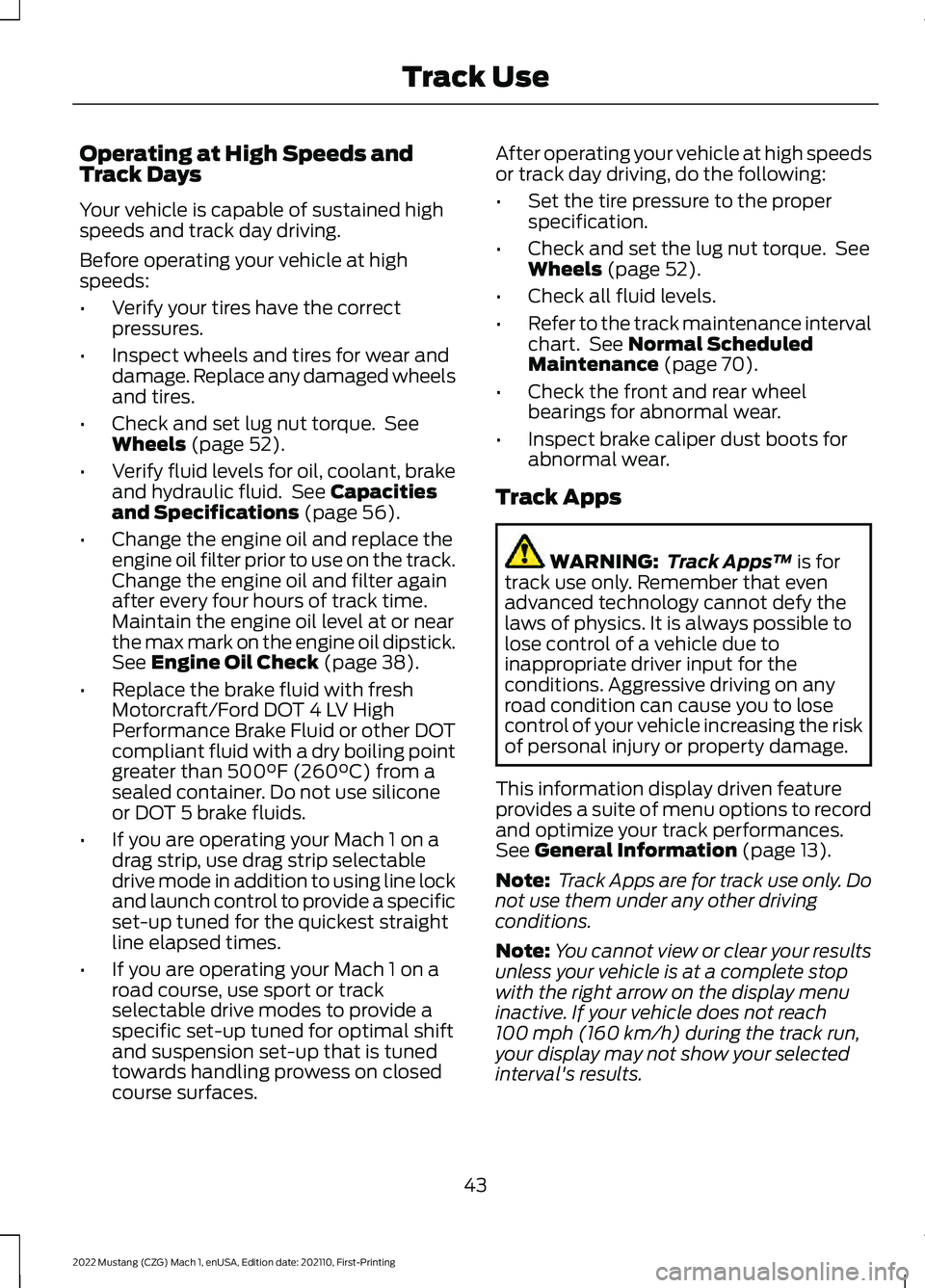
Operating at High Speeds and
Track Days
Your vehicle is capable of sustained high
speeds and track day driving.
Before operating your vehicle at high
speeds:
•
Verify your tires have the correct
pressures.
• Inspect wheels and tires for wear and
damage. Replace any damaged wheels
and tires.
• Check and set lug nut torque. See
Wheels (page 52).
• Verify fluid levels for oil, coolant, brake
and hydraulic fluid. See
Capacities
and Specifications (page 56).
• Change the engine oil and replace the
engine oil filter prior to use on the track.
Change the engine oil and filter again
after every four hours of track time.
Maintain the engine oil level at or near
the max mark on the engine oil dipstick.
See
Engine Oil Check (page 38).
• Replace the brake fluid with fresh
Motorcraft/Ford DOT 4 LV High
Performance Brake Fluid or other DOT
compliant fluid with a dry boiling point
greater than
500°F (260°C) from a
sealed container. Do not use silicone
or DOT 5 brake fluids.
• If you are operating your Mach 1 on a
drag strip, use drag strip selectable
drive mode in addition to using line lock
and launch control to provide a specific
set-up tuned for the quickest straight
line elapsed times.
• If you are operating your Mach 1 on a
road course, use sport or track
selectable drive modes to provide a
specific set-up tuned for optimal shift
and suspension set-up that is tuned
towards handling prowess on closed
course surfaces. After operating your vehicle at high speeds
or track day driving, do the following:
•
Set the tire pressure to the proper
specification.
• Check and set the lug nut torque. See
Wheels
(page 52).
• Check all fluid levels.
• Refer to the track maintenance interval
chart. See
Normal Scheduled
Maintenance (page 70).
• Check the front and rear wheel
bearings for abnormal wear.
• Inspect brake caliper dust boots for
abnormal wear.
Track Apps WARNING:
Track Apps™
is for
track use only. Remember that even
advanced technology cannot defy the
laws of physics. It is always possible to
lose control of a vehicle due to
inappropriate driver input for the
conditions. Aggressive driving on any
road condition can cause you to lose
control of your vehicle increasing the risk
of personal injury or property damage.
This information display driven feature
provides a suite of menu options to record
and optimize your track performances.
See
General Information (page 13).
Note: Track Apps are for track use only. Do
not use them under any other driving
conditions.
Note: You cannot view or clear your results
unless your vehicle is at a complete stop
with the right arrow on the display menu
inactive. If your vehicle does not reach
100 mph (160 km/h)
during the track run,
your display may not show your selected
interval's results.
43
2022 Mustang (CZG) Mach 1, enUSA, Edition date: 202110, First-Printing Track Use
Page 47 of 81
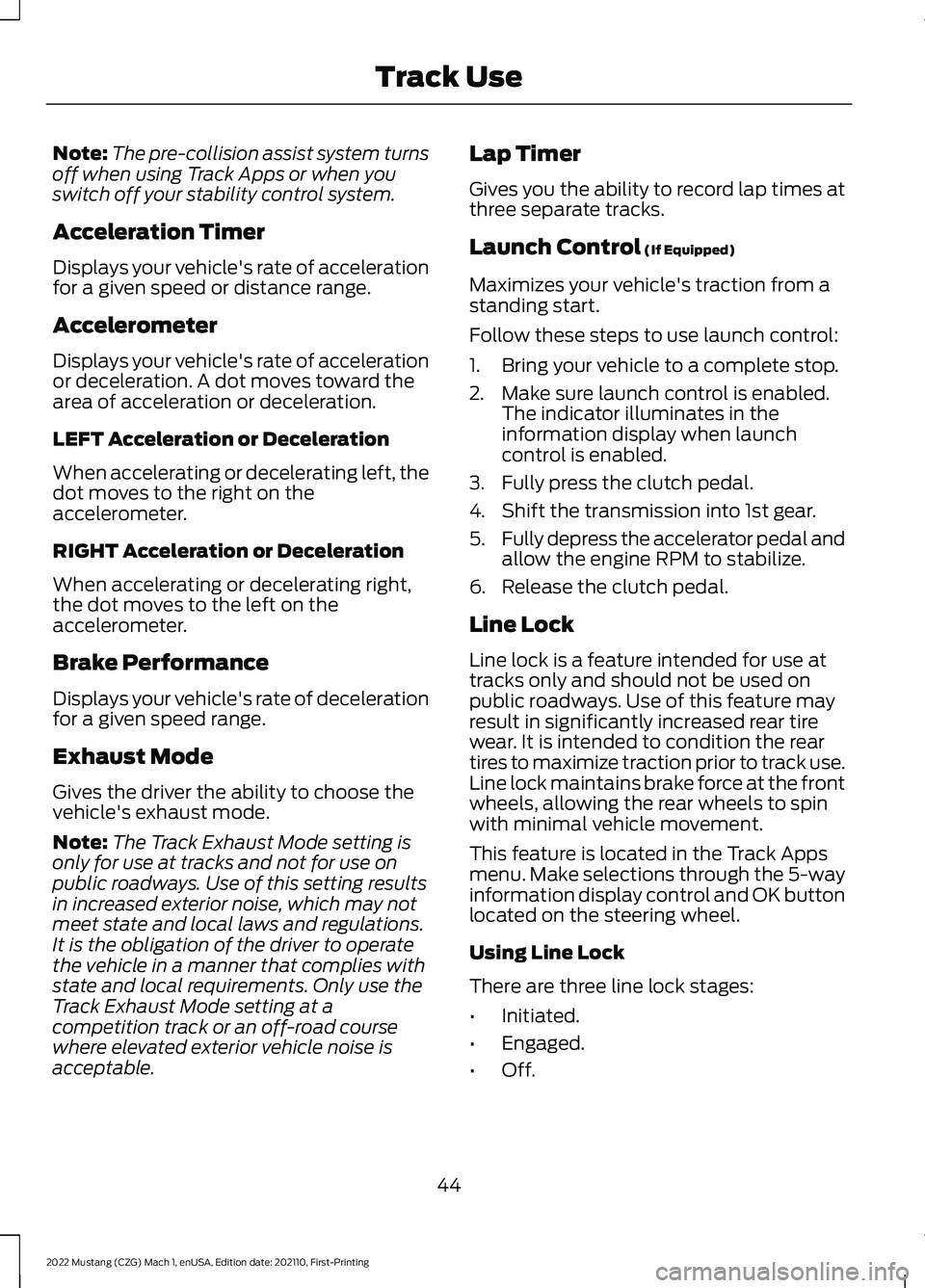
Note:
The pre-collision assist system turns
off when using Track Apps or when you
switch off your stability control system.
Acceleration Timer
Displays your vehicle's rate of acceleration
for a given speed or distance range.
Accelerometer
Displays your vehicle's rate of acceleration
or deceleration. A dot moves toward the
area of acceleration or deceleration.
LEFT Acceleration or Deceleration
When accelerating or decelerating left, the
dot moves to the right on the
accelerometer.
RIGHT Acceleration or Deceleration
When accelerating or decelerating right,
the dot moves to the left on the
accelerometer.
Brake Performance
Displays your vehicle's rate of deceleration
for a given speed range.
Exhaust Mode
Gives the driver the ability to choose the
vehicle's exhaust mode.
Note: The Track Exhaust Mode setting is
only for use at tracks and not for use on
public roadways. Use of this setting results
in increased exterior noise, which may not
meet state and local laws and regulations.
It is the obligation of the driver to operate
the vehicle in a manner that complies with
state and local requirements. Only use the
Track Exhaust Mode setting at a
competition track or an off-road course
where elevated exterior vehicle noise is
acceptable. Lap Timer
Gives you the ability to record lap times at
three separate tracks.
Launch Control (If Equipped)
Maximizes your vehicle's traction from a
standing start.
Follow these steps to use launch control:
1. Bring your vehicle to a complete stop.
2. Make sure launch control is enabled. The indicator illuminates in the
information display when launch
control is enabled.
3. Fully press the clutch pedal.
4. Shift the transmission into 1st gear.
5. Fully depress the accelerator pedal and
allow the engine RPM to stabilize.
6. Release the clutch pedal.
Line Lock
Line lock is a feature intended for use at
tracks only and should not be used on
public roadways. Use of this feature may
result in significantly increased rear tire
wear. It is intended to condition the rear
tires to maximize traction prior to track use.
Line lock maintains brake force at the front
wheels, allowing the rear wheels to spin
with minimal vehicle movement.
This feature is located in the Track Apps
menu. Make selections through the 5-way
information display control and OK button
located on the steering wheel.
Using Line Lock
There are three line lock stages:
• Initiated.
• Engaged.
• Off.
44
2022 Mustang (CZG) Mach 1, enUSA, Edition date: 202110, First-Printing Track Use
Page 69 of 81
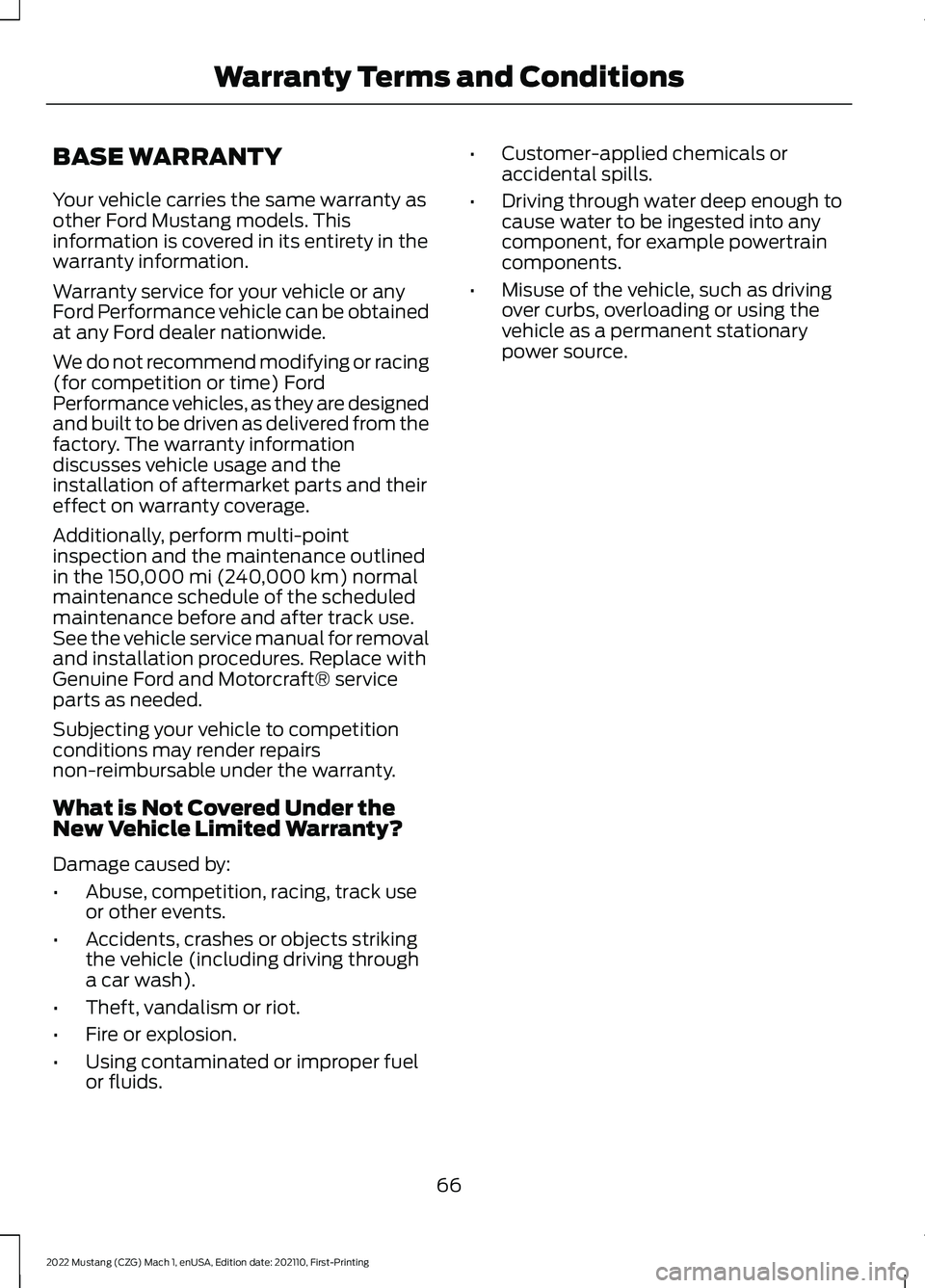
BASE WARRANTY
Your vehicle carries the same warranty as
other Ford Mustang models. This
information is covered in its entirety in the
warranty information.
Warranty service for your vehicle or any
Ford Performance vehicle can be obtained
at any Ford dealer nationwide.
We do not recommend modifying or racing
(for competition or time) Ford
Performance vehicles, as they are designed
and built to be driven as delivered from the
factory. The warranty information
discusses vehicle usage and the
installation of aftermarket parts and their
effect on warranty coverage.
Additionally, perform multi-point
inspection and the maintenance outlined
in the 150,000 mi (240,000 km) normal
maintenance schedule of the scheduled
maintenance before and after track use.
See the vehicle service manual for removal
and installation procedures. Replace with
Genuine Ford and Motorcraft® service
parts as needed.
Subjecting your vehicle to competition
conditions may render repairs
non-reimbursable under the warranty.
What is Not Covered Under the
New Vehicle Limited Warranty?
Damage caused by:
• Abuse, competition, racing, track use
or other events.
• Accidents, crashes or objects striking
the vehicle (including driving through
a car wash).
• Theft, vandalism or riot.
• Fire or explosion.
• Using contaminated or improper fuel
or fluids. •
Customer-applied chemicals or
accidental spills.
• Driving through water deep enough to
cause water to be ingested into any
component, for example powertrain
components.
• Misuse of the vehicle, such as driving
over curbs, overloading or using the
vehicle as a permanent stationary
power source.
66
2022 Mustang (CZG) Mach 1, enUSA, Edition date: 202110, First-Printing Warranty Terms and Conditions
Page 74 of 81
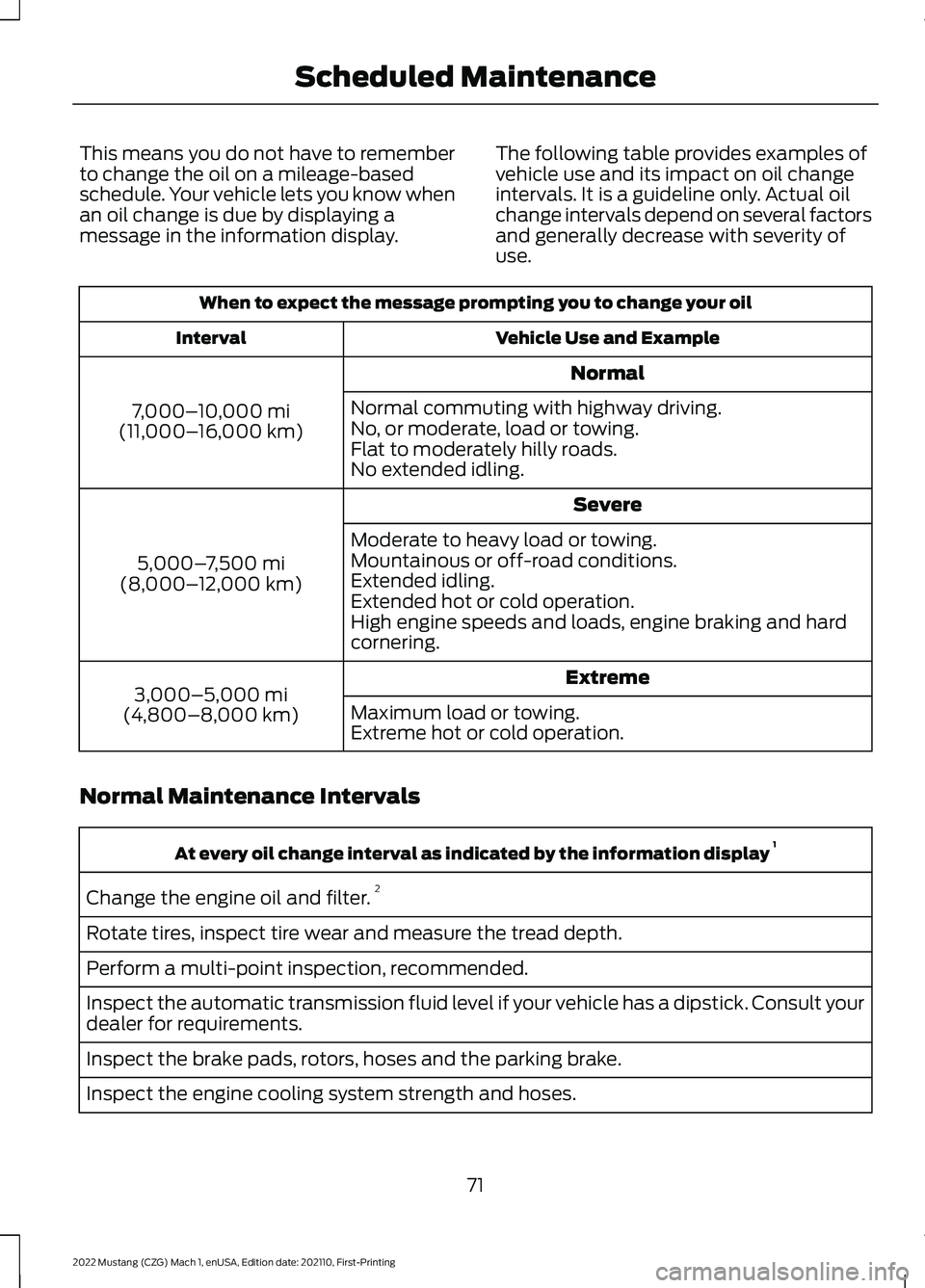
This means you do not have to remember
to change the oil on a mileage-based
schedule. Your vehicle lets you know when
an oil change is due by displaying a
message in the information display.
The following table provides examples of
vehicle use and its impact on oil change
intervals. It is a guideline only. Actual oil
change intervals depend on several factors
and generally decrease with severity of
use.When to expect the message prompting you to change your oil
Vehicle Use and Example
Interval
Normal
7,000– 10,000 mi
(11,000– 16,000 km) Normal commuting with highway driving.
No, or moderate, load or towing.
Flat to moderately hilly roads.
No extended idling.
Severe
5,000– 7,500 mi
(8,000– 12,000 km) Moderate to heavy load or towing.
Mountainous or off-road conditions.
Extended idling.
Extended hot or cold operation.
High engine speeds and loads, engine braking and hard
cornering.
Extreme
3,000–5,000 mi
(4,800–8,000 km) Maximum load or towing.
Extreme hot or cold operation.
Normal Maintenance Intervals At every oil change interval as indicated by the information display
1
Change the engine oil and filter. 2
Rotate tires, inspect tire wear and measure the tread depth.
Perform a multi-point inspection, recommended.
Inspect the automatic transmission fluid level if your vehicle has a dipstick. Consult your
dealer for requirements.
Inspect the brake pads, rotors, hoses and the parking brake.
Inspect the engine cooling system strength and hoses.
71
2022 Mustang (CZG) Mach 1, enUSA, Edition date: 202110, First-Printing Scheduled Maintenance